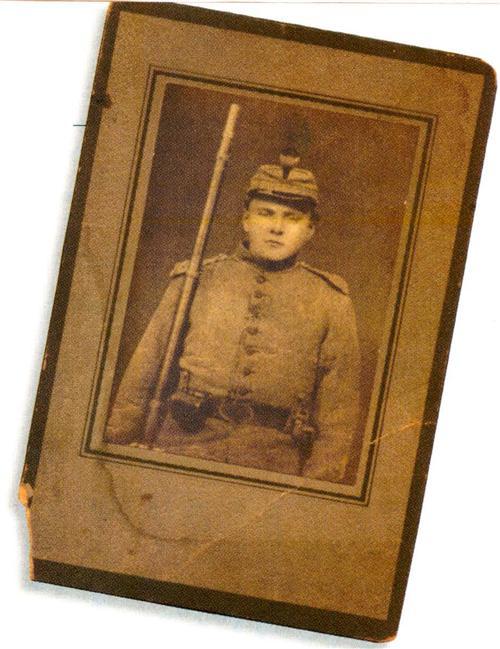Sign up for the Family Tree Newsletter Plus, you’ll receive our 10 Essential Genealogy Research Forms PDF as a special thank you!
Get Your Free Genealogy Forms
"*" indicates required fields

Count yourself lucky if you’ve found photos of forebears in military attire. When you know what to look for, those portraits can lead you right to your ancestors’ military service records. Susan Ferrell uncovered this portrait in her family photo collection, and she hopes the uniform will provide the necessary clues to produce a positive identification. Because such a wide variety of uniform designs appeared over the years, interpreting military images can be difficult. But Ferrell can find answers by following a few steps — and you can use the same procedure to identify your own military portraits.
Ferrell should start by establishing a time frame for the image, based on the photographic method. This picture’s a paper print, which means it dates from the mid-1850s or later. A photographer’s imprint could narrow the time frame by revealing the artist’s name and place of business. Using old city and photographer directories, Ferrell could then determine when he operated his studio. Unfortunately, this image lacks an imprint, so she’ll have to rely on costume clues instead.
Recognizing uniforms’ similarities and differences requires patience — but the research could help Ferrell find the answers she needs. It’s best to begin with a general uniform guide, such as Military Dress of North America, 1665-1970 by Martin Windrow and Gerry Embleton (Scribner, out of print). But if you’ve narrowed the time frame for one of your own images (say, Civil War era), consult a more-specialized costume encyclopedia such as Don Troiani’s Regiments and Uniforms of the Civil War by Don Troiani (Stackpole Books). An accessory such as a belt buckle with a state abbreviation could identify a Civil War soldier’s state of enlistment. Pay attention to these other key uniform elements, as well:
• Headgear: Through the years, US military units have worn caps, spiked helmets and tall hats — styles that also have appeared in European armies. Look to John P. Langellier and C. Paul Loane’s heavily illustrated U.S. Army Headgear, 1812-1872 (Schiffer Books, out of print) for advice on this topic. Although the book pictures plumed hats, none matches this young man’s headgear. Another strong resource is Mark Kasal and Don Moore’s A Guide Book to U.S. Army Dress Helmets, 1872-1904 (North Cape Publications).
• Decoration: To signify rank, uniforms often feature cloth chevrons (which look like upside-down Vs) on the sleeves and shoulders, and insignia on the collar or headgear. After 1863, badges and pins worn on headgear identified the corps with which a soldier served. Hash marks on the sleeves of Navy uniforms signify years of service. The lack of insignia on this man’s uniform makes it difficult to identify his military unit.
• Weapons and equipment: These details could identify an ancestor’s rank and branch of service. For instance, a man carrying a carbine probably joined a cavalry, while a man pictured with a pistol could be an officer. This man’s rifle and the equipment on his belt suggest he’s an infantryman.
If you fail to match the uniform in your picture with those in other resources, consult a military-materials specialist. You can find one by contacting a regional chapter of the Company of Military Historians <www.military-historians.org>.
Once you’ve narrowed the time span for the image you’re studying, enlist the help of a re-enactment group specializing in that era. Smoke & Fire News <www.smoke-fire.com>, a monthly newspaper for living history enthusiasts, can help you locate re-enactors near you. I spoke with a re-enactor about Ferrell’s portrait, and he suggested that the young man’s uniform resembles that of a military school soldier, not a regular infantryman. He also recommended searching the Virginia Military Institute Web site’s online photo archives at <www.vmi.edu/archives>.
Ferrell turned to the general genealogical community for help. A friend thought the image depicted someone in the German military, so Ferrell posted a query (with the image attached) on the German Military board at Ancestry.com<boards.ancestry.com>. Several genealogists commented on the portrait, but it remains unidentified.
It will take more research to identify this soldier’s uniform, but once we do, Ferrell can start tracking down service records (or school records if this is indeed a school uniform) for ancestors who could have joined the military at that time. (To learn more about military-records research, read the April 2002 Family Tree Magazine.) The odds are in Ferrell’s favor — and yours, too, if you have a picture like this one. The combination of distinctive costume clues and military historians willing to help should lead to a positive identification — eventually.
From the December 2004 issue of Family Tree Magazine.
ADVERTISEMENT

